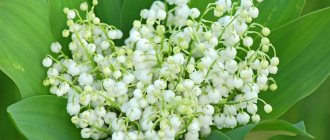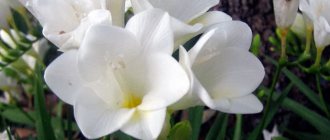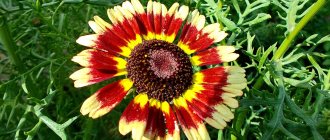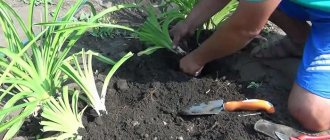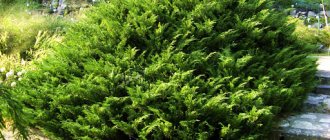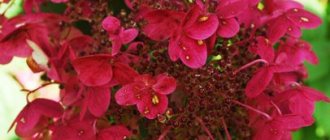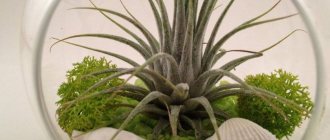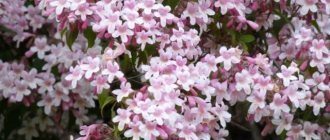Author: Natalya Category: Garden plants Published: March 07, 2018Republished: February 07, 2019Last edits: November 04, 2020
- Growing conditions
- Chionodoxa forbesii
Chionodoxa (lat. Chionodoxa) are low-growing perennials of the Scylla genus of the Liliaceae family, of which 6 species are known. Chionodoxes grow in Asia Minor and on the island of Crete. The name of the genus is formed from two Greek words: “snow” and “pride, glory”, and among the people Chionodoxa is called “snow beauty” or “snowman”: this delicate plant with wonderful flowers appears along with woodlands and snowdrops when it is still lying on the ground snow.
Planting and caring for Chionodoxa
- Flowering: for 2-3 weeks in April, together with snowdrops and scillas.
- Planting: September-October.
- Lighting: bright sun or partial shade.
- Soil: loose. Moderately moist, well fertilized, neutral or alkaline reaction.
- Watering: only during drought, that is, if the winter was without snow and spring without rain. Watering is carried out early in the morning.
- Feeding: Nitroammophoska. Granular fertilizers are scattered over the area and incorporated into the soil through shallow loosening.
- Reproduction: by dividing the bulbous nest.
- Pests: meadow root mites and rodents.
- Diseases: gray mold, sclerotinia, fusarium, septoria and Achelenchoides.
Read more about growing Chionodoxa below.
Botanical description
Chionodoxa flowers are bulbous plants with two basal leaves appearing simultaneously with the peduncles - dark green, broadly lanceolate, grooved, 8-12 cm long. The peduncles bear loose racemose inflorescences of bell-shaped six-petaled flowers of white, blue, indigo or pink. The fruit of the plant is a juicy capsule in which black Chionodoxa seeds ripen. The ovoid bulbs, up to 3 cm long and up to 1.7 cm in diameter, are covered with light scales and are designed for two annual cycles.
Use in landscape design
The perennial has become the most widespread due to its unpretentiousness and exceptionally early flowering, when there are not even the first shoots of tulips in the flowerbeds. The bulbs are planted among other perennials that appear a month later: tulips, daffodils, and decorative onions.
Beautiful chionodoxes, like rays of the sun playing on melting snowdrifts, decorate gardens in late February - early March. Pink, blue, blue or white - you can choose the bulbs and varieties to suit your taste.
Planting Chionodoxa in open ground
When to plant
It is best to plant Chionodoxa bulbs in early autumn, when root ridges have formed on their bottoms. The plant grows well both in sunny areas and in partial shade. If you want early flowering, plant the bulbs where the snow melts first. When grown in partial shade, flowering of Chionodoxa may begin a little later than in the sun, but will last longer. You can plant these plants even under trees and bushes, because when Chionodoxa blooms, there are still no leaves on the bushes and trees that absorb the light that primroses need for growth and flowering.
Chionodoxa in open ground is best adjacent to plants such as primroses, hellebores, hyacinths, crocuses, pushkinias, white flowers, adonis and dwarf irises.
- Rhododendron: cultivation, planting, care, varieties
How to plant
The soil on the site for Chionodoxa should be neutral or slightly alkaline, loose, moderately moist and well fertilized. The plant will settle in well and develop well if you add a little forest soil with rotted leaves and fragments of tree bark into the soil.
Planting Chionodoxa is carried out like planting any bulbous plant. How close and how deep to place Chionodoxa bulbs depends on their size. Large specimens are buried 6-8 cm, placing them in a row at a distance of 8-10 cm from each other. Smaller bulbs are buried 4-6 cm, keeping an interval of 6-8 cm between them.
Features of growing Chionodoxa
Location: Winter-hardy. Chionodox thrives in partial shade and sunlit areas. If you choose a place for planting where the snow melts first, flowering will be early. In partial shade it will begin a little later, but will last several days longer. It is believed that Chionodoxa does not tolerate shady places and should not be planted under trees. But the rare shade of deciduous trees, whose foliage appears late, will not harm chionodoxes. In addition, the best place for these magnificent plants is an alpine hill or rock garden, and these structures are rarely located in the shade.
Soil: require well-drained, good, humus-rich, fertile soil.
Care: in early spring, when arriving at the site, exercise extreme caution and, if possible, avoid places with pronounced bulbous plants, so as not to accidentally damage the sprouts located in the soft soil. After all, like all early flowering bulbs, Chionodoxa formed its flower shoots last year, and during the autumn and winter they were able to grow almost to the surface of the earth. One or two warm days are enough for the flower stalks to appear on the soil surface.
During this period, the plants' need for nutrients, mainly nitrogen, increases sharply, which necessitates the need to feed them. Sprinkle the fertilizer around the plants, being careful not to get it on the leaves, as this can cause burns. After applying fertilizer, shallowly loosen the soil surface to improve water and air conditions, as well as for faster absorption of nutrients by the plant root system.
When sowing seeds in the ground, young chionodoxa (Chionodoxa) bloom in 3-4 years. © Andrey Gudkov
Caring for Chionodoxa in the garden
Growing conditions
Planting and caring for Chionodoxa will not be difficult for you, since this flower is one of the most unpretentious early flowering plants. You will only need to water the flower garden if there was no snow in the winter and no rain in the spring. After moistening, you need to carefully loosen the soil around the plants, while removing weeds. To do this less often, mulch the surface of the area with humus or dry peat. Caring for chionodoxes includes fertilizing and replanting the plant, as well as, if necessary, treating the flower garden against pests or diseases. If you do not want Chionodox to reproduce by self-sowing, pick off their testes before they are ripe.
Watering and fertilizing
Systematic abundant watering is very important for Chionodoxa in dry weather. The soil is moistened early in the morning so that drops do not fall on the flowers. The water should not be cold and settled.
Mineral complexes are used as fertilizer, for example, Nitroammofoska, when applied in early spring, Chionodoxa responds with lush and long flowering. Granular fertilizers are scattered over the area, after which the surface is loosened shallowly so that it is quickly absorbed by the root system of the plants.
Transplantation and propagation
The easiest way for Chionodoxa to reproduce is vegetatively - by separating children from the mother's bulb, which grow from 2 to 4 in one season. In one place, Chionodoxa can grow for up to ten years, but it is better to dig up nests once every 5-6 years, separate them and seat. The bulbs need to be removed from the soil in the second half of July, when the above-ground part of the plant turns yellow and dries out. And the bulbs are planted in the ground, as we have already written, at the end of August or beginning of September, so before planting the nests are stored in a dry, dark place at a temperature of 15-17 ºC. Do not separate the babies from the mother bulb immediately after removal from the soil, because during storage the smallest of them may die. It is better to divide the nest before autumn planting, which is carried out according to the scheme we have already described.
- Gladiolus - planting and care
It is not advisable to grow Chionodoxa by seed, since they reproduce well by self-sowing: the seeds have a fleshy structure that is very popular with ants, who take the seeds far beyond the site. Chionodox from seeds bloom in 2-3 years.
Chionodoxa in winter
After flowering is completed, the chionodox shoots are cut off, but the leaves, as already written, are removed only after they wither - in the second or third decade of July. Chionodoxa tolerates winter frosts without any problems, but if you planted it in an open area, it is better to cover it with a heap of dry leaves or cover it with spruce paws for the winter. Although in the southern regions this precaution is unnecessary.
Flower propagation
Primrose can reproduce by bulbs and seeds. Bulb propagation involves the use of young bulbs. They are dug up in the 2nd week of July and stored in a cool room for 6–7 weeks. After which the chionodoxa is transplanted into the soil to a depth of 8–10 cm.
The plant can be replanted during the flowering period. But they do it quickly so that the root system does not dry out.
Planting of seeds is carried out immediately after they ripen. In the first 1–2 years, the primrose resembles spruce needles, so you need to mark and remember the planting location in advance. After ripening, the chionodoxa is transplanted to a permanent flowering site.
Pests and diseases
Like any other bulbous plant, Chionodoxa is susceptible to fungal diseases such as gray rot, sclerotinia, fusarium, septoria and Achelenchoides. The problem is that these diseases affect the bulb located underground, and we observe, as they say, the last act of the performance - yellowing and drying of the leaves, but we no longer have time to save the plant. Therefore, it is advisable to treat the planting material before planting in a Fundazol solution and observe moderation when watering, avoiding stagnation of water and, as a result, rotting of the bulbs.
The most dangerous pests for Chionodoxa are the larvae of root meadow mites and rodents that damage plant bulbs. Treating the plant with acaricidal preparations (Aktara, Akarin, Actellik, Agravertin and the like) is effective against ticks, and mice and moles are gotten rid of by spreading poisoned baits around the area.
Types and varieties
As already mentioned, scientists have described six species of Chionodoxa, but only three of them are grown in culture, as well as varieties and hybrids of different plant species.
Chionodoxa forbesii
Or Chionodoxa tmolusi is found naturally in southern Turkey. This species reaches a height of 25 cm. The plant forms a loose raceme on the peduncle, consisting of up to 15 white or pink flowers. This species does not produce seeds, but the bulbs grow annually as children. Chionodoxa Forbesia has been in culture since 1976. The following cultivated plant varieties are known:
- Alba - chionodoxa with snow-white flowers;
- Chionodoxa Blue Giant - a variety with perianths of intense blue color;
- Pink Giant is a garden form with lavender-pink flowers.
Chionodoxa luciliae
Or the giant chionodoxa (Chionodoxa gigantea) is named after Lucille Boissier. Chionodoxa grows in the mountains of Asia Minor, reaching a height of only 20 cm. The leaves of plants of this species are grooved and linear. Flowers, up to 3 cm in diameter, blue-blue with a white throat, are collected in inflorescences in quantities of up to 10 pieces. The species has been in cultivation since 1764. The following varieties of Chionodoxa Lucilia are popular:
- Whitewashing trees in spring: how and what to whitewash trees with
- white - a plant up to 10 cm high with white flowers up to 2.5 cm in diameter, of which there are 3-4 in one brush;
- pink – the color of the flowers is pink with a slight purple tint.
Gardeners are interested in a variety of pink variety - Chionodoxa Rose Queen (aka Rosie Queen or Pink Queen), the flowers of which are distinguished by a very beautiful shade of pink.
There is another variety of Chionodoxa Lucilia - a giant white one with flowers up to 4 cm in diameter.
Chionodoxa sardensis
also native to Asia Minor. This is a plant with two linear leaves, strong peduncles up to 12 cm high, which bear up to 10 bright blue flowers up to 2 cm in diameter, collected in a loose raceme. The plant has been in cultivation since 1885. The species has garden forms with white and pink flowers.
Also known are Chionodoxa dwarf, or Cretan, Chionodoxa whitish and Mrs. Lock, which were used to obtain new varieties, but have not yet been introduced into cultivation. With the participation of different species of Chionodoxa, breeder V. Khondyrev created a series of wonderful hybrids: Watercolor, Artemis, Absolute, Atlantis, Andromeda, Aphrodite and Arctic. Hybrids between related plants Chionodoxa Forbes and Scylla bifolia, which are called Chionoscilla, are also popular. They do not exceed 10 cm in height, and their small blue star-shaped flowers are formed not into loose inflorescences, like those of Chionodoxa, but into dense inflorescences.
